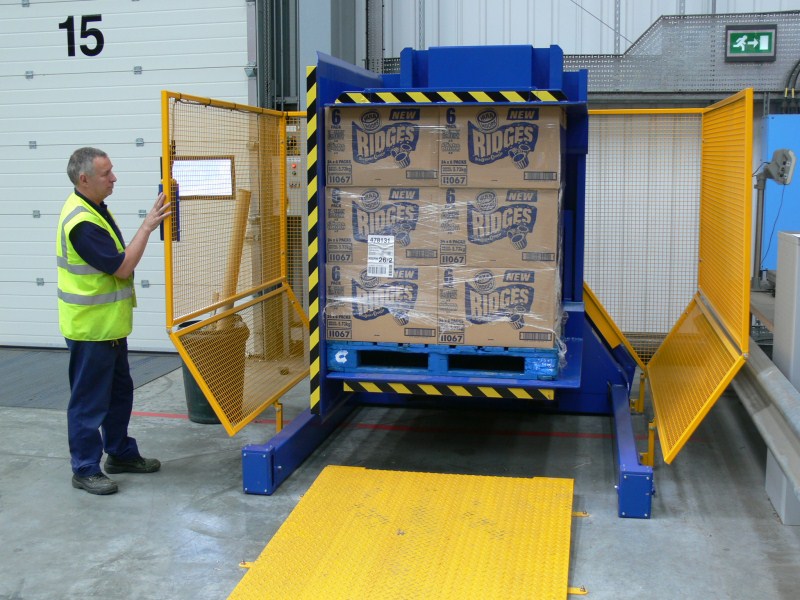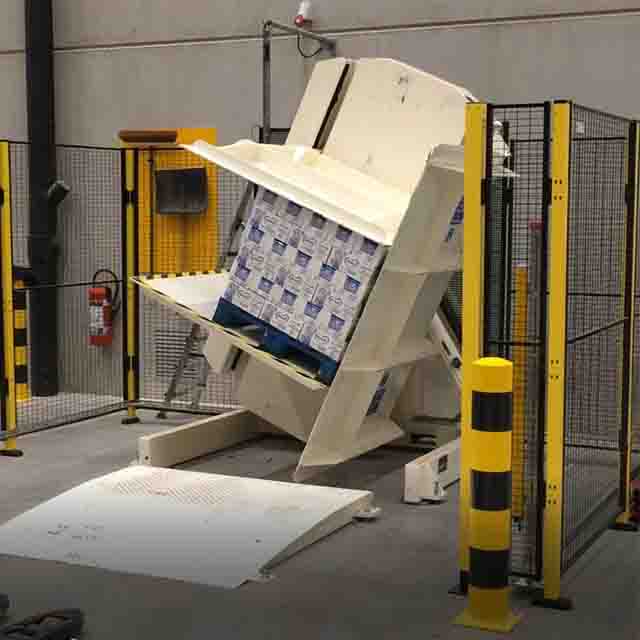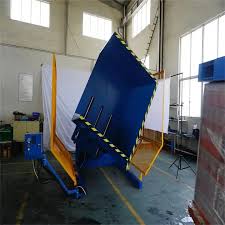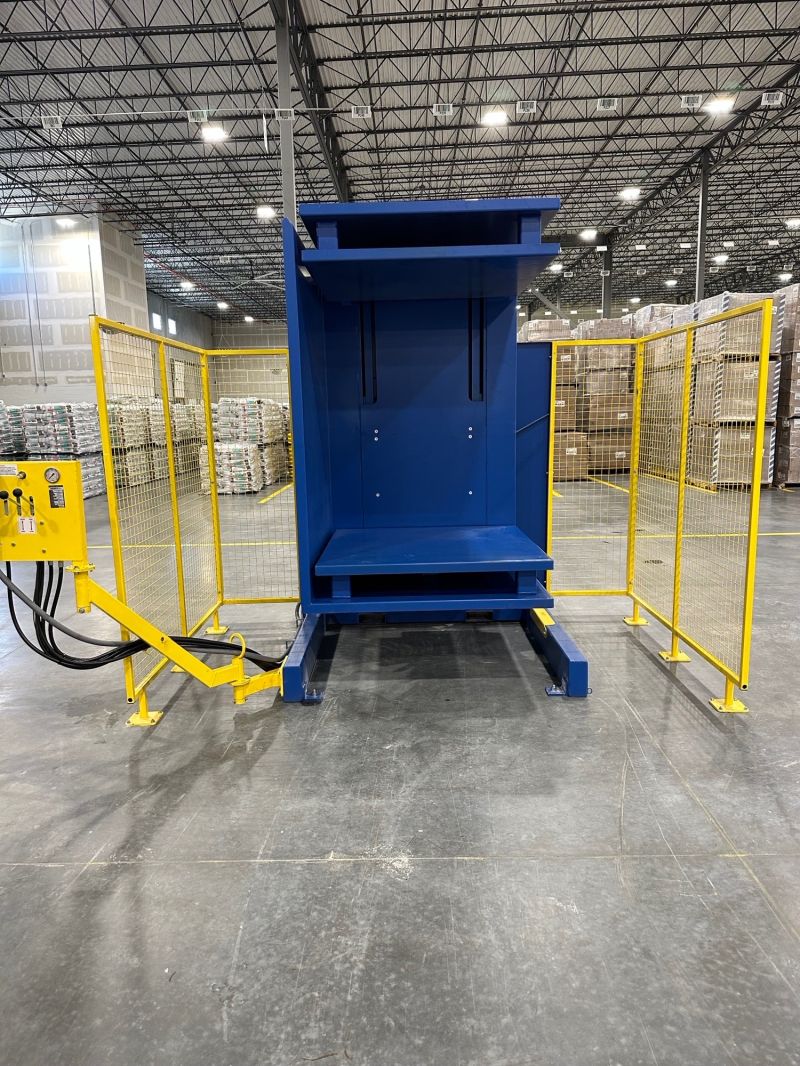How Pallet Inverters Solve Brexit-ready Pallet Change Compliance in the United Kingdom?
Are you struggling with the new logistics challenges of shipping to and from the United Kingdom? Since Brexit, many businesses have faced rejected shipments and costly delays, all because of a simple piece of wood: the pallet. The rules have changed, and manually switching entire loads from one pallet to another is slow, expensive, and risks damaging your goods and injuring your workers. This compliance headache is a major bottleneck that can quietly drain your profits and damage your reputation. But what if there was a machine that could solve this problem in under 60 seconds, with just one operator?
A pallet inverter is the definitive solution for achieving Brexit-ready pallet change compliance in the United Kingdom. This equipment automates the process of switching loads from internal, non-compliant pallets to ISPM 15-certified pallets required for international shipping. By securely clamping and rotating the entire load, it allows for a quick, safe, and damage-free pallet exchange. This not only guarantees that your shipments meet the strict post-Brexit regulations for wood packaging but also dramatically increases operational efficiency, reduces labor costs, and improves workplace safety.

This simple yet powerful solution transforms a major logistical problem into a minor, streamlined step in your process. It's not just about meeting a rule; it's about making your entire supply chain more robust, efficient, and profitable. As an engineer who has built a business from the ground up, I've seen how a single piece of smart equipment can remove a critical bottleneck and unlock new levels of growth. Let's dive deeper into how this works and why it's a strategic investment for any UK-focused business.
What are the specific post-Brexit pallet regulations affecting UK businesses?
Are you feeling uncertain about the exact pallet requirements for shipping between the UK and the EU? You're not alone. Many businesses were caught off guard by the changes, leading to confusion and costly mistakes at the border. The core of the problem is that a regulation that was once irrelevant for most UK-EU trade is now mandatory, and non-compliance means your goods simply won't cross the border. Ignoring this can lead to rejected shipments, frustrated customers, and unforeseen costs that eat into your margins.
The specific regulation is ISPM 15 (International Standards for Phytosanitary Measures No. 15). Before Brexit, as part of the EU Single Market, the UK did not need to follow these rules for trade with other member states. Now, all wood packaging material, including pallets, moving between the UK and the EU must be heat-treated and stamped with an ISPM 15 mark. This proves the wood has been treated to eliminate pests and diseases, a standard practice for global trade but a new requirement for this specific trade lane.

Understanding the ISPM 15 Standard
At its heart, ISPM 15 is a global passport for wood packaging. It was developed by the International Plant Protection Convention (IPPC) to prevent the international transport of pests and diseases that can devastate ecosystems. The standard mandates that wood packaging material (WPM) must be debarked and then treated with either heat treatment (HT) or fumigated with methyl bromide (MB). Heat treatment is by far the most common method.
Once treated by an accredited facility, the pallet is stamped with the official IPPC mark. This mark includes:
- The IPPC symbol.
- The two-letter ISO country code (e.g., GB for Great Britain).
- A unique code for the treatment provider.
- The abbreviation for the treatment used (e.g., HT for heat treatment).
Without this stamp, your pallet is considered non-compliant for international trade, including between the UK and the EU.
The "Before and After" of Brexit Compliance
To truly understand the impact, it's helpful to see the change in black and white. For decades, businesses operated under a different set of assumptions. The shift was abrupt and has had a significant impact on logistics planning. I've worked with many clients who had to overhaul their shipping processes almost overnight. They had warehouses full of standard "house" pallets that were suddenly unsuitable for their largest export market.
Here’s a simple breakdown of the change:
| Aspect | Pre-Brexit (UK-EU Trade) | Post-Brexit (UK-EU Trade) |
|---|---|---|
| Pallet Requirement | Any standard pallet (e.g., Euro, UK standard) was acceptable. | All wood pallets must be ISPM 15 compliant (heat-treated and stamped). |
| Documentation | No specific pallet documentation needed. | Proof of compliance (the ISPM 15 stamp) is required. |
| Border Checks | No routine checks for wood packaging compliance. | Border authorities can and do check for the ISPM 15 mark. |
| Consequences of Non-compliance | None. | Shipment can be rejected, returned, or destroyed at the shipper's expense. |
The consequences are the most critical part. It’s not a small fine; it's a complete stop. For a business owner like Javier, who prioritizes production stability and reliable delivery, a rejected shipment is a major disruption that ripples back through the entire production schedule. This is why addressing the pallet issue isn't just a shipping department problem; it's a strategic business imperative.
How does a pallet inverter directly improve operational efficiency beyond just compliance?
Your team is now forced to switch pallets to meet regulations. But how are they doing it? The common method is manual restacking. This involves workers physically unstacking an entire pallet of goods, one box or item at a time, and then restacking it onto a compliant pallet. This process is painfully slow, physically demanding, and a recipe for inefficiency. It creates a massive bottleneck in your warehouse, requires multiple staff members, and drastically increases the risk of product damage and workplace injuries. The time and labor you waste on this one task could be used for much more valuable activities.
A pallet inverter improves operational efficiency by replacing this slow, manual process with a fast, automated one. A single operator can use the machine to switch an entire pallet load in about 60 seconds. It eliminates the need for manual handling, freeing up your staff for other tasks. This accelerates your entire shipping workflow, from the end of the production line to the loading dock. By turning a 30-minute, multi-person job into a one-minute, one-person task, the pallet inverter directly addresses the goals of increasing throughput and reducing operational costs.

Quantifying the Efficiency Gains
When I work with clients, I always focus on the numbers. Talk is cheap, but data shows the real value. Let’s compare the manual method to using a pallet inverter. For a business owner like Javier, who aims to boost equipment uptime to 95% and cut costs, this comparison is crucial. The time wasted on manual pallet swapping is time your production line is waiting, or your trucks are sitting idle.
Let's break down the impact on key areas:
Labor and Time Savings
Imagine a typical scenario: a pallet loaded with steel components or boxes of finished goods.
- Manual Method: This requires at least two workers. The process of carefully unstacking and restacking can take anywhere from 15 to 30 minutes, depending on the load's stability and weight. It's a full-on manual labor job.
- Pallet Inverter Method: This requires one operator. The machine clamps the load, rotates it 180 degrees, and the old pallet can be removed from the top. A new, compliant pallet is placed, and the load is rotated back. The entire cycle takes 1-2 minutes.
| Metric | Manual Restacking | Pallet Inverter | Improvement Factor |
|---|---|---|---|
| Personnel Required | 2-3 Workers | 1 Operator | 50-67% Reduction |
| Time per Pallet | 20 Minutes (average) | 1 Minute | 20x Faster |
| Pallets per Hour | 3 Pallets | 60 Pallets | 2000% Increase in Throughput |
These aren't small improvements. They represent a fundamental shift in how your logistics operate.
Enhancing Workplace Safety
Javier’s experience, from team leader to owner, means he understands the real cost of a workplace injury. It’s not just about medical bills or insurance. It’s about lost productivity, low morale, and the disruption to a well-run team. Manual restacking is a high-risk activity involving constant bending, lifting, and twisting—all primary causes of musculoskeletal injuries. A single pallet of steel wire coils or metal parts can weigh over a ton. Manually handling this is out of the question, but even handling smaller boxes repeatedly leads to strain.
A pallet inverter eliminates almost all of this manual effort. The operator controls the machine from a safe distance. This drastically reduces the risk of back injuries, sprains, and strains. For a company focused on operational excellence, creating a safer work environment is a direct contributor to stability and lower costs.
Protecting Product Quality
Every time a product is handled, there is a risk of damage. When workers are manually unstacking and restacking, boxes can be dropped, packaging can be torn, and sensitive goods can be compromised. This leads to unsaleable stock, customer complaints, and returns.
A pallet inverter handles the entire load as a single, stable block. The clamping pressure is adjustable to be firm enough to secure the load without crushing it. The rotation is smooth and controlled. This ensures that your products arrive at the pallet-swapping station in perfect condition and leave in the same condition, just on a different pallet. For high-value goods, preventing even a small percentage of damage can lead to significant savings.
What are the key financial considerations when investing in a pallet inverter?
As a practical business owner, you know that every investment must have a clear return. You've likely analyzed major capital expenditures, like a new furnace or production line, with intense scrutiny. A pallet inverter is a smaller investment, but the principle is the same. You're asking: What is the upfront cost, what are the ongoing expenses, and how quickly will it pay for itself? Simply hearing that it "saves money" isn't enough. You need to see the hard numbers to justify the purchase and ensure it aligns with your goal of lowering overall operating costs by 8% or more.
The key financial consideration is a Return on Investment (ROI) calculation that balances the initial purchase price against the tangible, recurring savings it generates. These savings come primarily from massively reduced labor costs, increased throughput, eliminated product damage, and lower injury-related expenses. When you calculate the daily cost of your current manual process—including wages, lost time, and damages—and compare it to the one-time cost of the machine, the financial case often becomes compellingly clear in a matter of months, not years.

Calculating the Total Cost of Ownership (TCO)
A smart investment analysis goes beyond the sticker price. It looks at the Total Cost of Ownership (TCO), which includes the initial purchase, installation, and ongoing operational costs. In my experience building a factory, understanding TCO was the key to making decisions that were profitable in the long run.
- Capital Expenditure (CAPEX): This is the upfront cost of the pallet inverter itself. The price can vary based on the model, capacity, and features. A standard 180-degree inverter for typical loads might have a certain cost, while a heavy-duty model designed for steel coils or a machine with automated infeed/outfeed conveyors will be higher. Installation is usually straightforward and can often be done by your own maintenance team, but it's a cost to consider.
- Operating Expenses (OPEX): This is where pallet inverters truly shine.
- Energy: They are remarkably efficient. The hydraulic or electric motor only runs for the brief period of clamping and rotation, consuming very little energy compared to a machine that runs continuously. Javier's goal of reducing unit energy consumption is supported by this low-draw equipment.
- Maintenance: These are robust, simple machines. Regular maintenance involves checking hydraulic fluid levels, lubricating moving parts, and inspecting hoses. The costs are minimal, especially compared to complex production machinery.
- Labor: This is the biggest operational saving, not a cost. The single operator is already accounted for, and you're saving the wages of the 1-2 additional workers who were previously needed.
The ROI Calculation: A Practical Example
Let’s put some numbers to this. Assume you need to swap 50 pallets per day.
Manual Method Cost:
- Labor: 2 workers x £15/hour/worker = £30/hour
- Time per pallet: 20 minutes (0.33 hours)
- Cost per pallet: £30/hour x 0.33 hours = £10
- Daily Labor Cost: 50 pallets x £10/pallet = £500
Pallet Inverter ROI:
- Initial Investment (Example): £25,000
- Labor: 1 operator x £15/hour = £15/hour
- Time per pallet: 1 minute (1/60th of an hour)
- Cost per pallet: £15/hour x (1/60) hours = £0.25
- Daily Labor Cost: 50 pallets x £0.25/pallet = £12.50
- Daily Savings: £500 - £12.50 = £487.50
Payback Period:
- £25,000 (Investment) / £487.50 (Daily Savings) = 51.3 business days
In this conservative example, the machine pays for itself in just over two months. After that, it's generating nearly £500 in pure labor savings every single day. This calculation doesn't even include the significant financial benefits of avoiding product damage, preventing injuries, or the value of faster shipment processing. For a data-driven leader like Javier, this kind of clear, quantifiable return is exactly what justifies an investment.
| Financial Factor | Without Pallet Inverter (Annual Cost) | With Pallet Inverter (Annual Cost + Savings) |
|---|---|---|
| Direct Labor Cost | £125,000 (based on £500/day for 250 days) | £3,125 (based on £12.50/day) |
| Product Damage | ~1-2% of goods value (e.g., £10,000) | Negligible (<0.1%) |
| Injury Risk Cost | High (Potential for lost time, insurance claims) | Very Low |
| Initial Investment | £0 | -£25,000 (Year 1 only) |
| Net Financial Impact (Year 1) | -£135,000 Cost | +£96,875 Net Savings (125k+10k - 3.1k - 25k) |
My Insights on Choosing the Right Pallet Inverter Partner
Over the years, from my first days on the factory floor to running my own company, I’ve learned one lesson that stands above all others: the machine is only part of the solution. The partner you choose to buy it from is just as important. When you invest in critical equipment, you are not just buying steel and hydraulics; you are buying a relationship. You are buying expertise, reliability, and support. A cheap machine from a supplier who disappears after the sale can become the most expensive mistake you ever make.
When you're looking for a solution, especially for something as critical as your logistics chain, you need more than a vendor. You need a strategic partner. This is a partner who takes the time to understand your specific challenges—whether it's handling heavy steel wire coils or fragile electronic components. They should be able to look at your operation and provide a solution that integrates seamlessly, not just one that comes out of a standard catalog. This is the difference between simply solving a problem and creating a true competitive advantage.

Look for Expertise, Not Just a Product
I remember when I bought my first major wrapping machine for my own factory. I spoke with several suppliers. One offered the lowest price, but their salesperson couldn't answer my detailed questions about cycle times with my specific product. Another supplier was more expensive, but their engineer sat with me for hours, sketching out how the machine would fit into my line and suggesting modifications to the guards to improve safety for my team. I chose the second supplier, and it was the best decision I made. That machine ran flawlessly for years because it was the right solution, not just the cheapest one.
Apply this same logic to choosing a pallet inverter partner.
- Do they understand your load? A partner who has experience with heavy, dense loads like those in the steel industry will know that you need a robust machine with strong clamping power and durable construction. They will ask about the weight and dimensions of your steel coils or stacked sheets.
- Can they customize? What if you need stainless steel construction for a food-grade or corrosive environment? Or specific safety features like light curtains or fencing to meet your plant's standards? A true partner can accommodate these needs.
- Do they offer a range of solutions? A good partner won't push a single model. They will have a portfolio—from 180-degree inverters to pallet exchangers that push the load from one pallet to another—and will help you select the one that fits your space, budget, and workflow.
A Partnership Extends Beyond Installation
The relationship truly begins after the machine is installed. This is where a strategic partner proves their worth. For a leader like Javier, who is focused on digitalization and long-term stability, this is non-negotiable.
| Here’s what you should demand from your partner: | Support Area | What a Vendor Does | What a Partner Does |
|---|---|---|---|
| Installation & Training | Sends a manual and expects you to figure it out. | Provides on-site support to ensure correct installation and offers comprehensive training for your operators and maintenance staff. | |
| After-Sales Support | Hard to reach. Slow to respond with spare parts. | Has a dedicated support team. Maintains a stock of critical spare parts for fast shipment to minimize your downtime. | |
| Future-Proofing | Sells you today's technology. | Discusses your long-term goals. Advises on how the equipment can integrate with your future MES or IoT platforms for data collection and predictive maintenance. | |
| Proactive Advice | Sells the machine and moves on. | Stays in touch. Informs you of new upgrades, best practices, and helps you continuously optimize your process. |
Choosing a partner with this mindset is how you turn a simple equipment purchase into a long-term strategic asset that supports your goals for efficiency, digitalization, and profitability. It's the philosophy I built my own company on, and it's what I look for in every business relationship.
Conclusion
Ultimately, a pallet inverter is more than a compliance tool. It is a strategic investment in efficiency, safety, and profitability, turning a post-Brexit challenge into a significant operational advantage.


